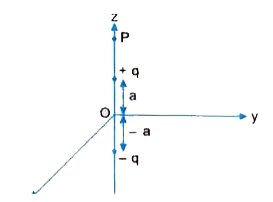Two charges - q and +q are located at points (0, 0, - a) and (0,0, a), respectively.
How much work is done in moving a small test charge from the point (5, 0, 0) to (-7,0,0) along the x-axis ? Does the answer change if the path of the test charge between the same points is not along the x-axis ?
The given charges behave as an electric dipole and the dipole length is 2a, hence dipole moment p=q.2a.
As the motion of test charge from the point (5, 0, 0) to (-7,0,0) is along x-axis and electric potential is only along z-axis, hence work done = 0.
The answer does not change because the electric field is a conservative field and the work done simply depends on the position of initial and final points only.

Topper's Solved these Questions
- ELECTROSTATIC POTENTIAL AND CAPACITANCE BOOK - U-LIKE SERIESCHAPTER - ELECTROSTATIC POTENTIAL AND CAPACITANCE EXERCISE - CASE BASED/SOURCE-BASED INTEGRATED QUESTIONS
18 Videos
- ELECTROSTATIC POTENTIAL AND CAPACITANCE BOOK - U-LIKE SERIESCHAPTER - ELECTROSTATIC POTENTIAL AND CAPACITANCE EXERCISE - MULTIPLE CHOICE QUESTIONS
35 Videos
- ELECTROSTATIC POTENTIAL AND CAPACITANCE BOOK - U-LIKE SERIESCHAPTER - ELECTROSTATIC POTENTIAL AND CAPACITANCE EXERCISE - SELF ASSESSMENT TEST
1 Videos
- ELECTROMAGNETICE INDUCTIONBOOK - U-LIKE SERIESCHAPTER - ELECTROMAGNETICE INDUCTIONEXERCISE - Self Assessment Test Section -D
1 Videos
- EXAMINATION PAPER 2020 (SOLVED)BOOK - U-LIKE SERIESCHAPTER - EXAMINATION PAPER 2020 (SOLVED)EXERCISE - SECTION D
6 Videos
Similar Questions
Two charges - q and + q are located at points A(0, 0, -a) and B(0, 0, +a) respectively. How much work is done in moving a test charge from point P(7,0,0) to Q(-3,0,0) ?
View SolutionTwo charges −qand+q are located at points A(0,0,−a)andB(0,0+a). How much work is done in moving a test charge from point (b,0,0) to Q(−b,0,0) ?
View Solution
Knowledge Check
Two point charges −q and +q are located at points (0,0−a) and (0,0,a) resepctively.The electric potential at point (0,0,z)is (Z>a)
Aqa4πε0z2Bq4πε0aC2qa4πε0(z2−a2)D2qa4πε0(z2+a2)
(i) Can two equpotential surfaces intersect each other ? Give reason.
(ii) Two charges +qand−q are located at points A (0,0,−2)andB(0,0,2) respectively. How much work will be done in moving a test charge from point P(4,0,0) to (−5,0,0) ?
View SolutionTwo charges -q and +q are located at points (0, 0, –a) and (0, 0, a), respectively.
(a) What is the electrostatic potential at the points (0, 0, z) and (x, y, 0) ? (b) Obtain the dependence of potential on the distance r of a point from the origin when r/a>>1.
(c) How much work is done in moving a small test charge from the point (5,0,0) to (–7,0,0) along the x-axis? Does the answer change if the path of the test charge between the same points is not along the x-axis?
View SolutionTwo point charges q and - q are located at points (0 , 0 , - a ) and (0 , 0 , a) respectively :
(a) Find the electrostatic potential at (0 , 0 , z) and ( x, y , 0).
(b) How much work is done in moving a small test charge from the point (5 , 0 , 0 , ) to (-7 , 0 , 0 ) along the x - axis ?
(c) How would your answer change if the path of the test charge between the same points is not along the x axis but along any other random path ?
(d) If the above point charges are now placed in the same position in a uniform external electric field →E , what would be the potential energy of the charge system in its orientation of unstable equilibrium ? Justify your answer in each case .
View SolutionTwo point charges q and - q are located at points (0 , 0 , - a ) and (0 , 0 , a) respectively :
(a) Find the electrostatic potential at (0 , 0 , z) and ( x , y , 0).
(b) How much work is done in moving a small test charge from the point (5 , 0 , 0 , ) to (-7 , 0 , 0 ) along the x - axis ?
(c) How would your answer change if the path of the test charge between the same points is not along the x axis but along any other random path ?
(d) If the above point charges are now placed in the same position in a uniform external electric field →E, what would be the potential energy of the charge system in its orientation of unstable equilibrium ? Justify your answer in each case .
View SolutionTwo charges -q and +q are located at points (0, 0, –a) and (0, 0, a), respectively.
(a) What is the electrostatic potential at the points (0, 0, z) and (x, y, 0) ? (b) Obtain the dependence of potential on the distance r of a point from the origin when r/a>>1.
(c) How much work is done in moving a small test charge from the point (5,0,0) to (–7,0,0) along the x-axis? Does the answer change if the path of the test charge between the same points is not along the x-axis?
View SolutionTwo charges - q and +q are located at points (0, 0, - a) and (0,0, a), respectively.
What is the electrostatic potential at the points (0, 0, z) and (x, y,0) ?
View SolutionTwo point charges −q and +q are located at points (0,0−a) and (0,0,a) respectively. The electric potential at point (0,0,z)is (Z>a)
View Solution
